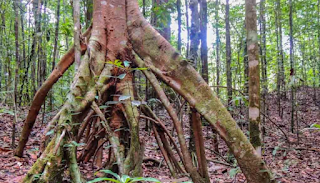Forests in the tropics can be considered ‘biodiversity hotspots’. As well as supporting a vast
array of vegetation, they provide shelter and nourishment for a wealth of wildlife. Depending on the area of land covered, forests can even affect the local and regional climate – cooling and refreshing the tropical atmosphere.
Rainforests have a clearly identifiable structure – and each vertical layer has a distinctly different type of vegetation and wildlife associated with it. The ‘bushy’ leafy tree level of the forest is known as the ‘canopy’. This is where birds and primates predominantly live. Occasionally huge trees pierce through the canopy, extending towards the sunlight; and these occupy the ‘emergent layer’.
In the understory layer beneath the canopy there are smaller trees such as tree ferns and lianas, which are long-stemmed, climbing woody vines. Lianas use the tree trunks for support as they climb to reach the sunlight they need to survive. They coil around and between the trees and often appear to hang like long ropes.
http://www.baldhiker.com/2017/03/26/discovering-tropical-rainforests/
array of vegetation, they provide shelter and nourishment for a wealth of wildlife. Depending on the area of land covered, forests can even affect the local and regional climate – cooling and refreshing the tropical atmosphere.
Rainforests have a clearly identifiable structure – and each vertical layer has a distinctly different type of vegetation and wildlife associated with it. The ‘bushy’ leafy tree level of the forest is known as the ‘canopy’. This is where birds and primates predominantly live. Occasionally huge trees pierce through the canopy, extending towards the sunlight; and these occupy the ‘emergent layer’.
In the understory layer beneath the canopy there are smaller trees such as tree ferns and lianas, which are long-stemmed, climbing woody vines. Lianas use the tree trunks for support as they climb to reach the sunlight they need to survive. They coil around and between the trees and often appear to hang like long ropes.
http://www.baldhiker.com/2017/03/26/discovering-tropical-rainforests/












No comments:
Post a Comment